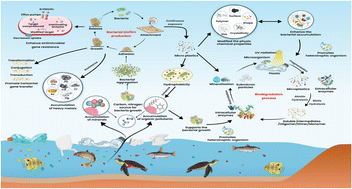Microplastic emerging pollutants – impact on microbiological diversity, diarrhea, antibiotic resistance, and bioremediation
Abstract
Advanced economic development and technologies cause worldwide plastic waste to increase many folds, leaving policymakers with the dilemma of managing it. Synthetic solid particles or polymeric matrices of plastics with diverse shapes and sizes are the primary concern of environmental pollution of the marine ecosystem, freshwater, agriculture fields, atmosphere, food, drinking water, and other remote locations. Researchers demonstrated microplastics (MPs) as multifaceted stressors in the ecosystem, carrying toxic chemicals and vectors of transport, and described the implications of these hazardous chemicals on human health. MPs in the environment can adsorb organic, nitrogenous substances and other minerals. This complex system may promote microbial growth and aggregation. Continuous contact of microbes with MPs changes the internal arrangement of ions and atoms, alternating physio-chemical properties and becoming hydrophobic. These properties allow specific bacterial growth on MPs and promote bacterial resistance and transfer of resistance genes. MPs aged by ultra-violet light, temperature, and chemicals increase bacterial adsorption and antibiotic-resistance gene transfer synergistically. MPs are mitigated in the environment by aggregation of microbes, which leads to aging and loss of the crystalline structure of microplastic due to the release of enzymes that cause oxidation, demethylation and desertification, and hydrolysis of MPs. Aerobic conditions are preferred to degrade MPs in different environmental conditions for large-scale degradation of MPs. However, anaerobic degradation requires controlled conditions and specialized equipment. The use of a consortium of bacteria increases biodegradation efficiency. Among the microorganisms, fungi were the most effective at detoxicating xenobiotics in the environment due to their adaptability and ability to tolerate diverse conditions. This critical review analyses microplastic-induced microbial diversity and microbial adaptations to it. Furthermore, it describes MP's role in the cause of diarrhea, antimicrobial resistance, and spread. The potential use of bioremediation methods and pathways for eliminating MPs like phthalates and bisphenol from ecosystems is discussed in detail. Finally, suggestions are put forward for controlling and removing MPs from the environment.

- This article is part of the themed collections: 2025 REV Collection from Environmental Science: Advances , Environmental Science Advances Recent Review Articles, Methods for Early Warning of Chemicals of Emerging Concern and Topic Collection: Microplastics


 Please wait while we load your content...
Please wait while we load your content...